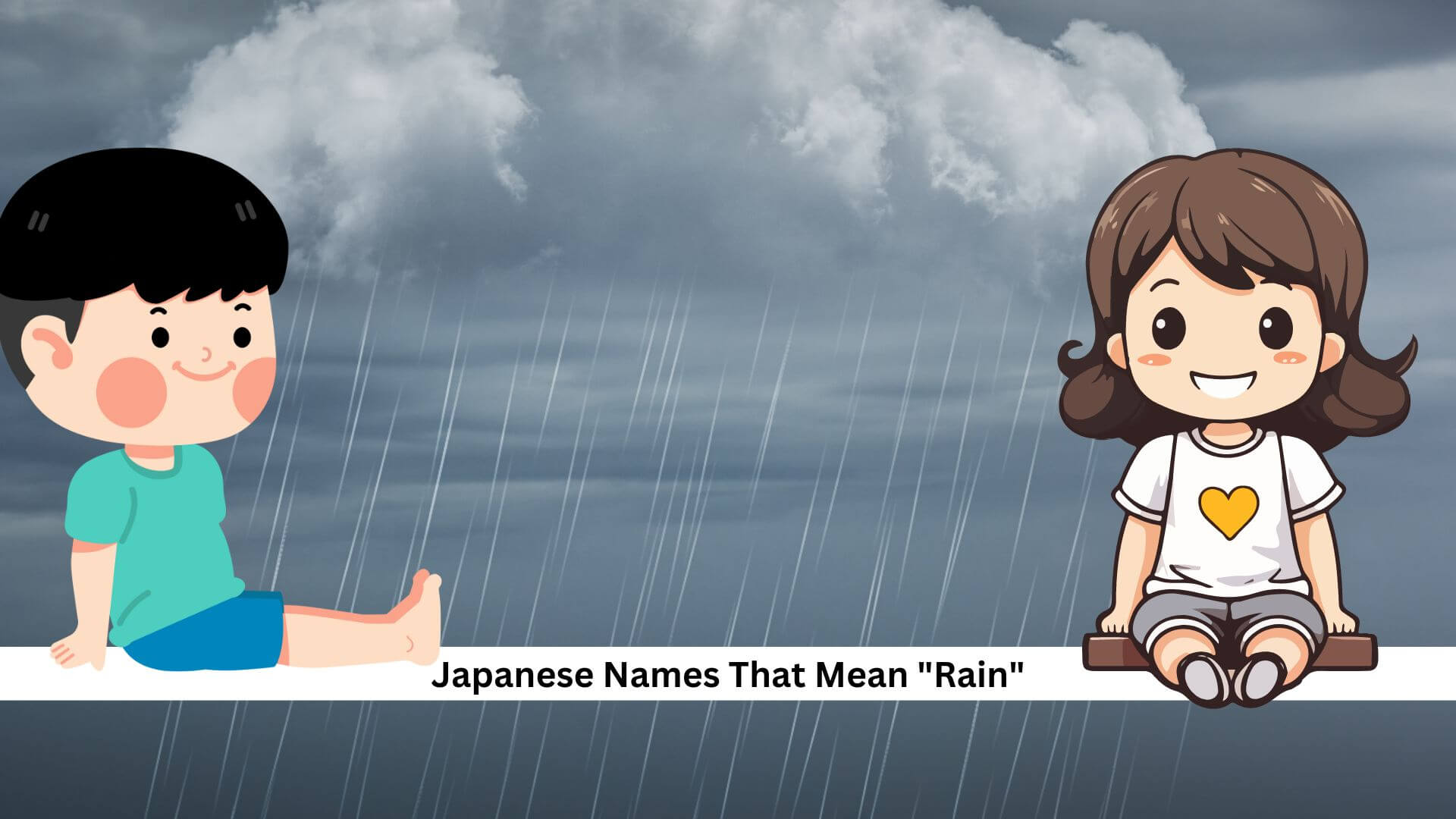Choosing a name is deeply meaningful. It reflects hopes, culture, and family history. In Japanese culture, names meaning ‘rain’ are quite special. They symbolize the nourishing aspects of rain, and qualities like resilience and adaptability. We’re looking at over 145 Japanese names tied to ‘rain.’ These names reflect society’s values and its strong bond with nature. Each name, whether it’s clearly masculine, feminine, or unisex, tells a story. Let’s dive into the stories and cultural meanings behind these names.
The Role of Rain in Japanese Culture
In Japanese culture, people value rain a lot. It’s important because it helps sustain life and has deep meanings too. It stands for new beginnings and shows how life is always changing. These ideas are big in everyday life and in spiritual thinking. When it comes to farming, rain is key, especially for growing rice. This links closely with what people eat every day and how the country makes money. So, rain is really important in Japanese culture and even shows up in their art.
Female Japanese Names That Reflect “Rain”
When you look at Japanese female names that mean ‘rain,’ you see how much they value nature and renewal. These names aren’t just beautiful; they connect deeply with the life-giving aspect of rain. It’s about capturing that fleeting beauty of rain in a name that stays with a person forever.
- Amaya (雨夜) – “Night rain,” symbolizing the beauty and calmness of rain falling at night.
- Umeha (梅雨葉) – “Rain in plum blossom season,” representing the soft rains that nurture the spring flowers.
- Rina (里雨) – “Village rain,” evoking the peaceful atmosphere of rain falling on rural landscapes.
- Sazame (細雨) – “Light drizzle,” capturing the gentle touch of a soft rain.
- Ame (雨) – “Rain,” a simple and direct representation of the natural phenomenon itself.
- Shigure (時雨) – “Late autumn rain,” linked to the seasonal rain that brings a sense of nostalgia.
- Ameiko (雨子) – “Child of rain,” symbolizing someone born during a rainstorm or blessed by rain.
- Amemi (雨美) – “Beautiful rain,” evoking the visual beauty of rain as it falls.
- Tsubame (雨燕) – “Rain swallow,” inspired by the birds that fly during light rain showers.
- Sorame (空雨) – “Sky rain,” representing the connection between the sky and the falling rain.
- Kirisame (霧雨) – “Mist rain,” capturing the fine, misty rain that feels like a whisper.
- Amezora (雨空) – “Rainy sky,” symbolizing the expansive sky filled with soft rain.
- Amari (雨里) – “Rain village,” evoking the image of a peaceful village under a gentle rain.
- Samidare (五月雨) – “Early summer rain,” linked to the first rains of the summer season.
- Amehana (雨花) – “Rain blossom,” symbolizing flowers blooming under a nurturing rain.
- Namika (波雨花) – “Wave and rain flower,” representing the blend of rain and ocean waves.
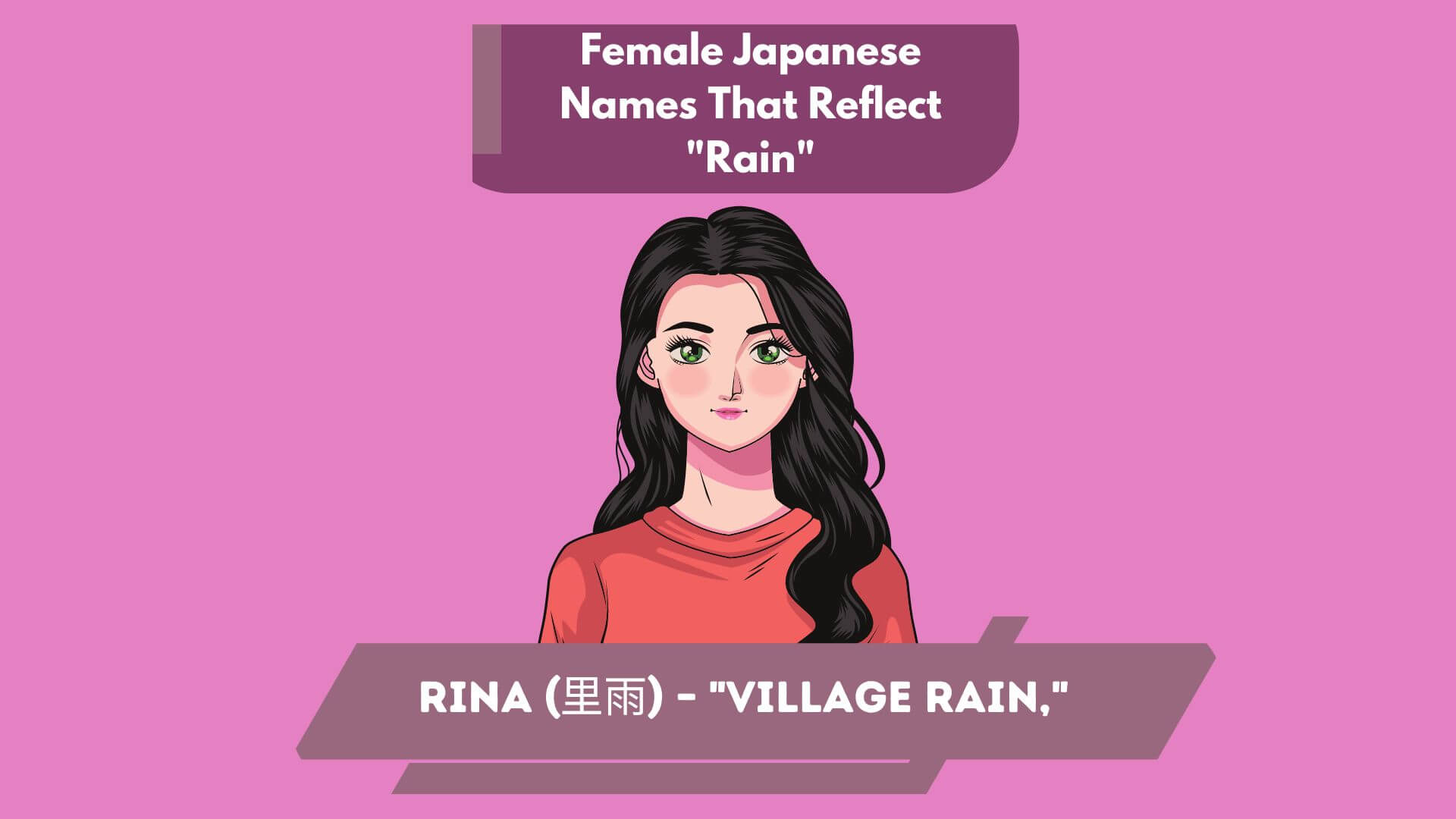
- Soraame (空雨) – “Rain from the sky,” emphasizing the celestial connection to rain.
- Nozami (野雨) – “Field rain,” reflecting the refreshing rain that nourishes fields and crops.
- Ameko (雨湖) – “Rain lake,” capturing the image of rain rippling over a still lake.
- Suzuka (涼雨香) – “Cool rain fragrance,” referring to the refreshing scent of rain in the air.
- Hazame (葉雨) – “Leaf rain,” symbolizing rain as it falls softly on leaves.
- Harusame (春雨) – “Spring rain,” evoking the feeling of renewal and new beginnings through rain.
- Minari (水雨里) – “Water rain village,” combining water and rain to represent life in a serene place.
- Ameha (雨波) – “Rain waves,” inspired by the movement of rain creating ripples on water.
- Kuroame (黒雨) – “Dark rain,” symbolizing the moodiness and depth of a heavy rainstorm.
- Asame (浅雨) – “Shallow rain,” referring to a light rain that doesn’t linger long but refreshes the land.
- Ritsume (律雨) – “Rhythmic rain,” representing the steady, calming pattern of rain.
- Tokiame (時雨) – “Rain of time,” symbolizing the passage of time with each rainfall.
- Uruame (潤雨) – “Moist rain,” connected to the nurturing quality of rain that brings life.
- Kazame (風雨) – “Wind and rain,” reflecting the powerful combination of rain driven by the wind.
- Amehana (雨華) – “Rain flower,” representing a rare and delicate flower that thrives in the rain.
Male Japanese Names That Evoke “Rain”
Many Japanese male names are inspired by rain, capturing its calm and vital nature. For example, ‘Ame’ means ‘rain.’ It brings to mind purity and a fresh start. ‘Hisame’ translates to ‘long-lasting rain,’ suggesting persistence and ongoing life. These names deeply connect with nature and have meaningful cultural ties. They reflect the quiet strength and vital support that rain offers.
- Amaya (雨弥) – “Night rain,” symbolizing the quiet strength found in rain falling at night.
- Raiden (雷電) – “Thunder and lightning,” evoking the powerful storms that accompany rain.
- Ameo (雨男) – “Rain man,” representing someone born during rain or with a strong connection to it.
- Amatsuki (雨月) – “Rainy moon,” capturing the serene beauty of rain falling under the moonlight.
- Shinrai (深雷) – “Deep thunder,” evoking the sound of thunder rolling through a rainstorm.
- Shigure (時雨) – “Autumn rain,” symbolizing the changing seasons and the transition of life.
- Ameharu (雨晴) – “Clear after rain,” representing hope and renewal after a storm.
- Ameki (雨樹) – “Rain tree,” symbolizing strength and growth nourished by rain.
- Uruo (潤男) – “Moist man,” reflecting someone who brings renewal like the rain.
- Nariaki (鳴雨) – “Sound of rain,” referring to the peaceful sound of rain falling on the ground.
- Amekaze (雨風) – “Rain and wind,” symbolizing the dynamic forces of nature.
- Kirisame (霧雨) – “Mist rain,” representing the subtle, gentle rain that touches the earth softly.
- Amejiro (雨次郎) – “Second son of rain,” a traditional name linking one to the rains.
- Sorame (空雨) – “Sky rain,” evoking the connection between the heavens and the falling rain.
- Ameitsu (雨逸) – “Swift rain,” symbolizing the sudden, quick showers that pass by.
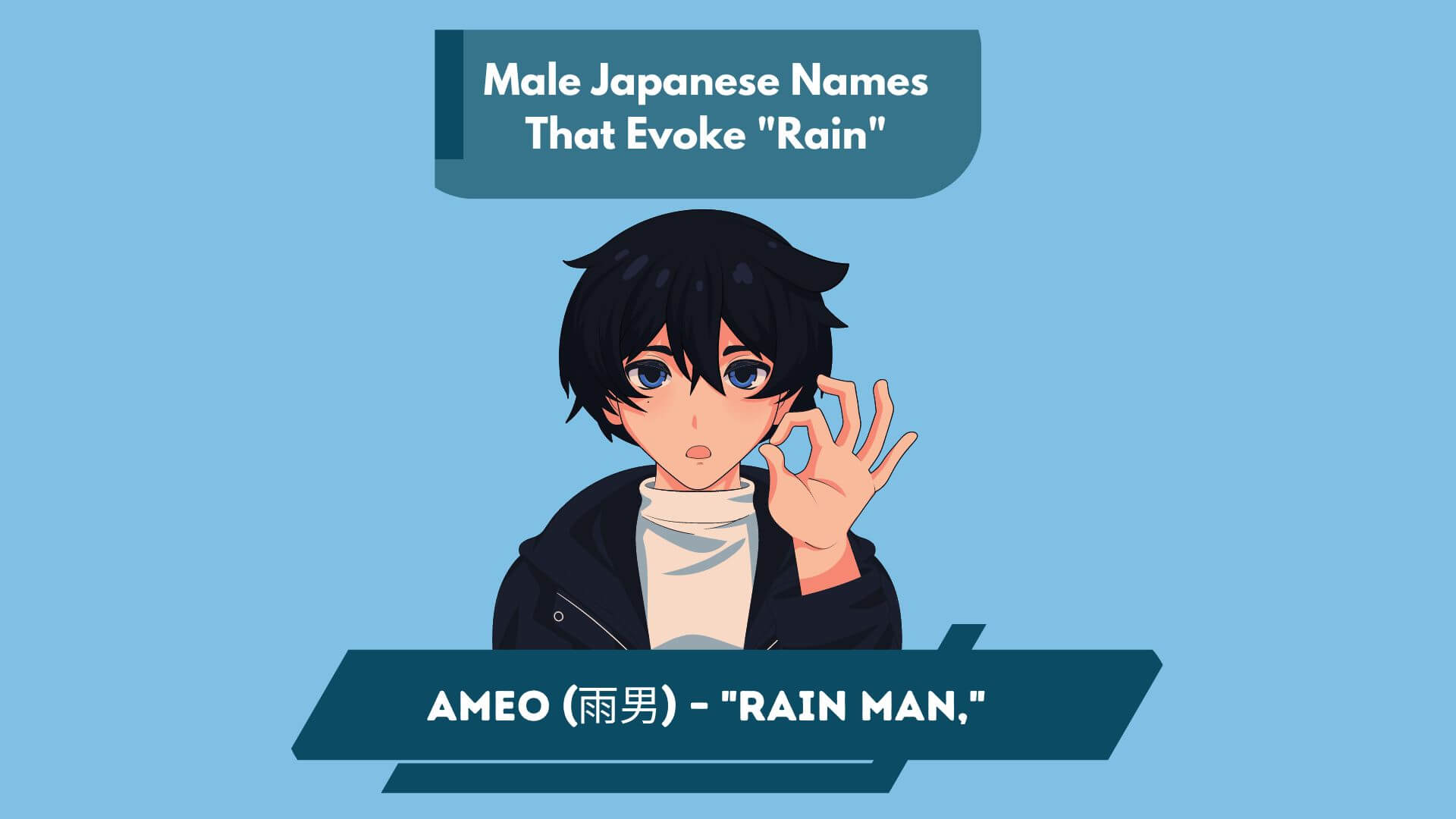
- Samidare (五月雨) – “Early summer rain,” tied to the seasonal rains that begin in summer.
- Ameryu (雨竜) – “Rain dragon,” symbolizing the mythical power of rain and the creatures of water.
- Kazame (風雨) – “Wind and rain,” reflecting the powerful combination of these natural forces.
- Ameaki (雨秋) – “Rainy autumn,” representing the melancholy yet beautiful rains of autumn.
- Reisame (霊雨) – “Spiritual rain,” evoking the cleansing and sacred qualities of rain.
- Hazuki (葉雨樹) – “Leaf and rain tree,” symbolizing growth sustained by the rain’s nurturing touch.
- Miname (水雨) – “Water and rain,” representing the unity of water in all its forms.
- Tokiame (時雨) – “Rain of time,” capturing the passage of time through each rainfall.
- Amekai (雨海) – “Rain ocean,” reflecting the vastness of water connecting rain to the sea.
- Kuroame (黒雨) – “Dark rain,” symbolizing the power and depth of a heavy downpour.
- Harusame (春雨) – “Spring rain,” representing renewal and the beginning of life through rain.
- Ritsume (律雨) – “Rhythmic rain,” capturing the steady beat of raindrops that bring calm.
- Uruame (潤雨) – “Moist rain,” symbolizing the enriching qualities of rain that rejuvenate life.
- Amefuyu (雨冬) – “Winter rain,” representing the rare and delicate rains of the colder months.
- Amekou (雨光) – “Rain and light,” symbolizing the beauty of sunlight breaking through the rain.
- Takisame (滝雨) – “Waterfall rain,” evoking the powerful, cascading force of rain that resembles a waterfall.
Unisex Japanese Names that Connect to Rain
Let’s talk about how rain influences Japanese names. There are unisex names that really bring out the nature of rain, showing both its strength and its refreshing qualities. These names are popular because they deeply connect with nature and culture.
- Ame (雨) – “Rain,” a simple yet powerful name representing the essence of rain itself.
- Amaya (雨夜) – “Night rain,” evoking the calming presence of rain falling during the quiet of night.
- Shigure (時雨) – “Autumn rain,” symbolizing the seasonal rains that bring change and reflection.
- Sorame (空雨) – “Sky rain,” representing the vast connection between the sky and falling rain.
- Ametsuki (雨月) – “Rainy moon,” capturing the serene beauty of rain under the moonlight.
- Ameka (雨華) – “Rain flower,” symbolizing delicate flowers that bloom under nourishing rain.
- Samidare (五月雨) – “Early summer rain,” connected to the gentle rains that come in early summer.
- Kirisame (霧雨) – “Mist rain,” evoking the soft and gentle touch of a light, misty rain.
- Uruame (潤雨) – “Moist rain,” symbolizing the life-giving nature of rain that brings renewal.
- Amezora (雨空) – “Rainy sky,” referring to the sky covered with rain clouds and their promise of refreshment.
- Amekaze (雨風) – “Rain and wind,” capturing the force of rain combined with the movement of the wind.
- Hazame (葉雨) – “Leaf rain,” representing rain as it falls softly onto the leaves.
- Takisame (滝雨) – “Waterfall rain,” evoking the powerful and steady flow of rain like a waterfall.
- Amehana (雨花) – “Rain blossom,” symbolizing the blossoming of flowers nurtured by rain.
- Miname (水雨) – “Water rain,” representing the unity of rain and water in nature.
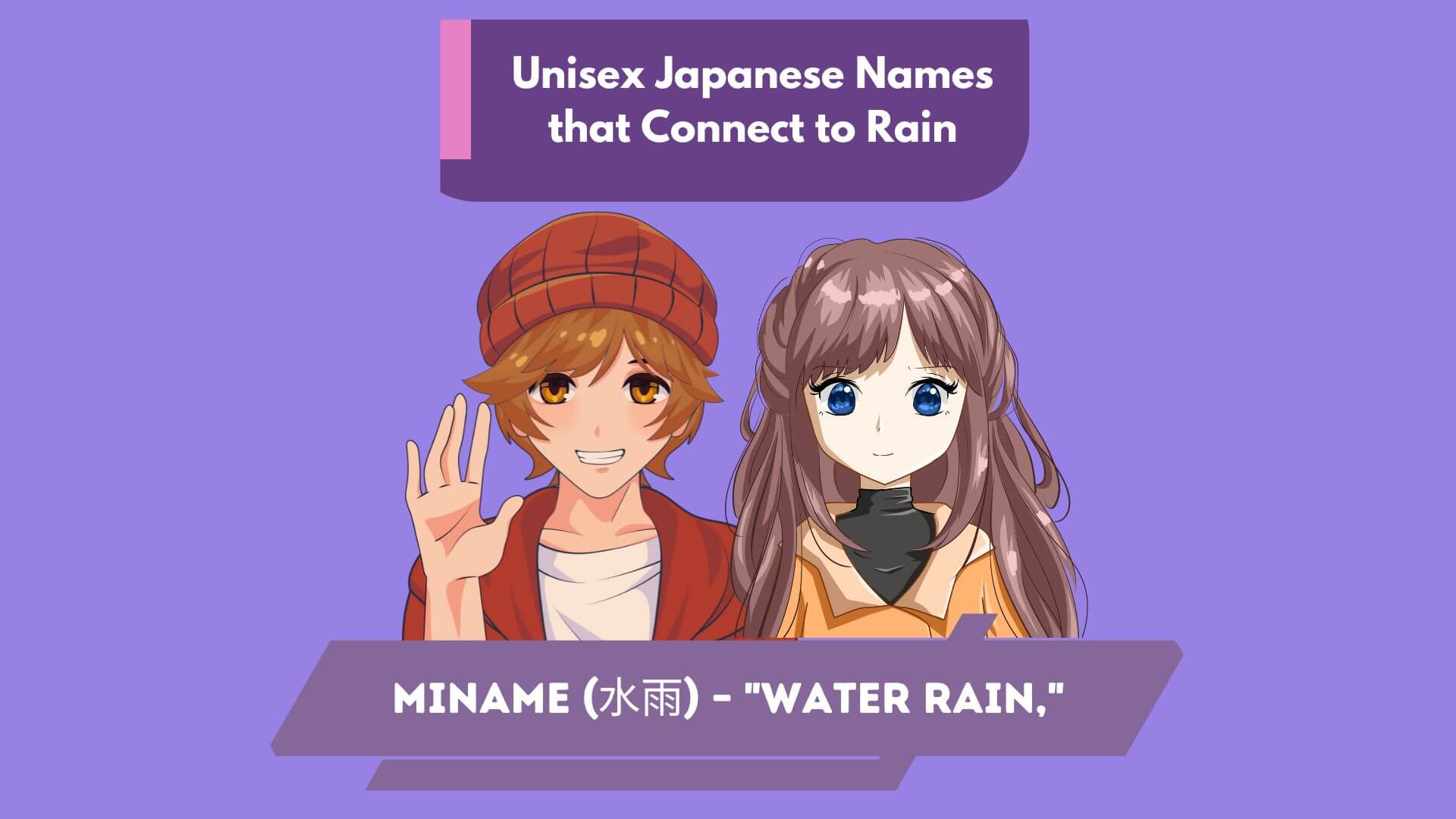
- Amekaoru (雨薫) – “Fragrance of rain,” capturing the refreshing scent that rain brings to the earth.
- Ritsume (律雨) – “Rhythmic rain,” representing the steady and calming sound of raindrops.
- Ameharu (雨晴) – “Clear after rain,” symbolizing the hope and peace that comes after a storm.
- Kazame (風雨) – “Wind and rain,” reflecting the dynamic and harmonious interaction between rain and wind.
- Amekai (雨海) – “Rain ocean,” evoking the vastness and connection between rain and the sea.
- Ameaki (雨秋) – “Rainy autumn,” symbolizing the calming and reflective nature of autumn rains.
- Ameo (雨緒) – “Rain thread,” representing the thin, delicate lines of rain falling from the sky.
- Nozame (野雨) – “Field rain,” symbolizing the gentle rains that nurture fields and crops.
- Amemitsu (雨光) – “Rain light,” capturing the beautiful moments when sunlight pierces through the rain.
- Reisame (霊雨) – “Spiritual rain,” representing the cleansing and sacred aspects of rain.
- Amefuyu (雨冬) – “Winter rain,” symbolizing the rare and gentle rains that fall during the winter months.
- Kuroame (黒雨) – “Dark rain,” representing the intensity and depth of a heavy downpour.
- Asame (浅雨) – “Shallow rain,” evoking a light, passing rain that refreshes without lingering.
- Amefuji (雨富士) – “Rain on Mt. Fuji,” symbolizing the beauty of rain as it falls on Japan’s iconic mountain.
- Ameha (雨波) – “Rain wave,” representing the ripples created by rain as it falls on water.
- Ameryu (雨竜) – “Rain dragon,” symbolizing the mythical and powerful connection between rain and nature.
Also Read: 100+ Japanese Names That Mean “Star” And Their Meanings
Unique and Rare Japanese Names with a Rain Connection
Exploring unique and rare Japanese names tied to rain is fascinating. These names are not just unique; they capture the essence of rain in their sound and meaning. They’re perfect for those looking for something different. Each name reflects rain’s role in life and renewal, a deep part of Japanese culture.
- Ametsuki (雨月) – “Rainy moon,” symbolizing the serene beauty of the moon behind a curtain of rain.
- Rairei (雷霊) – “Thunder spirit,” representing the spiritual energy in thunderstorms and rain.
- Ameiwa (雨岩) – “Rain rock,” evoking the image of rain splashing on ancient stones.
- Shizuku (雫) – “Raindrop,” capturing the delicacy and beauty of a single drop of rain.
- Kaseame (風雨) – “Wind rain,” symbolizing the harmony between rain and wind in nature’s cycle.
- Ameyasu (雨安) – “Peaceful rain,” reflecting the calming and soothing presence of gentle rain.
- Rensame (蓮雨) – “Lotus rain,” evoking the image of rain falling on lotus flowers, symbolizing purity.
- Ameku (雨雲) – “Rain cloud,” representing the source of rain that nurtures the earth.
- Ameyori (雨頼) – “Rain reliance,” symbolizing the rain’s role in sustaining life and nature.
- Amehana (雨華) – “Rain blossom,” depicting the blossoming of flowers brought to life by rain.
- Sasame (細雨) – “Fine rain,” representing a light, gentle rain that softly nourishes the land.
- Amekage (雨影) – “Rain shadow,” symbolizing the mysterious beauty of shadows formed during rain.
- Inasame (稲雨) – “Rice rain,” representing the essential rain that nurtures rice fields.
- Ametsuru (雨鶴) – “Rain crane,” linking the grace of a crane with the elegance of falling rain.
- Shinsame (深雨) – “Deep rain,” evoking the image of a strong and steady rain that soaks deep into the earth.
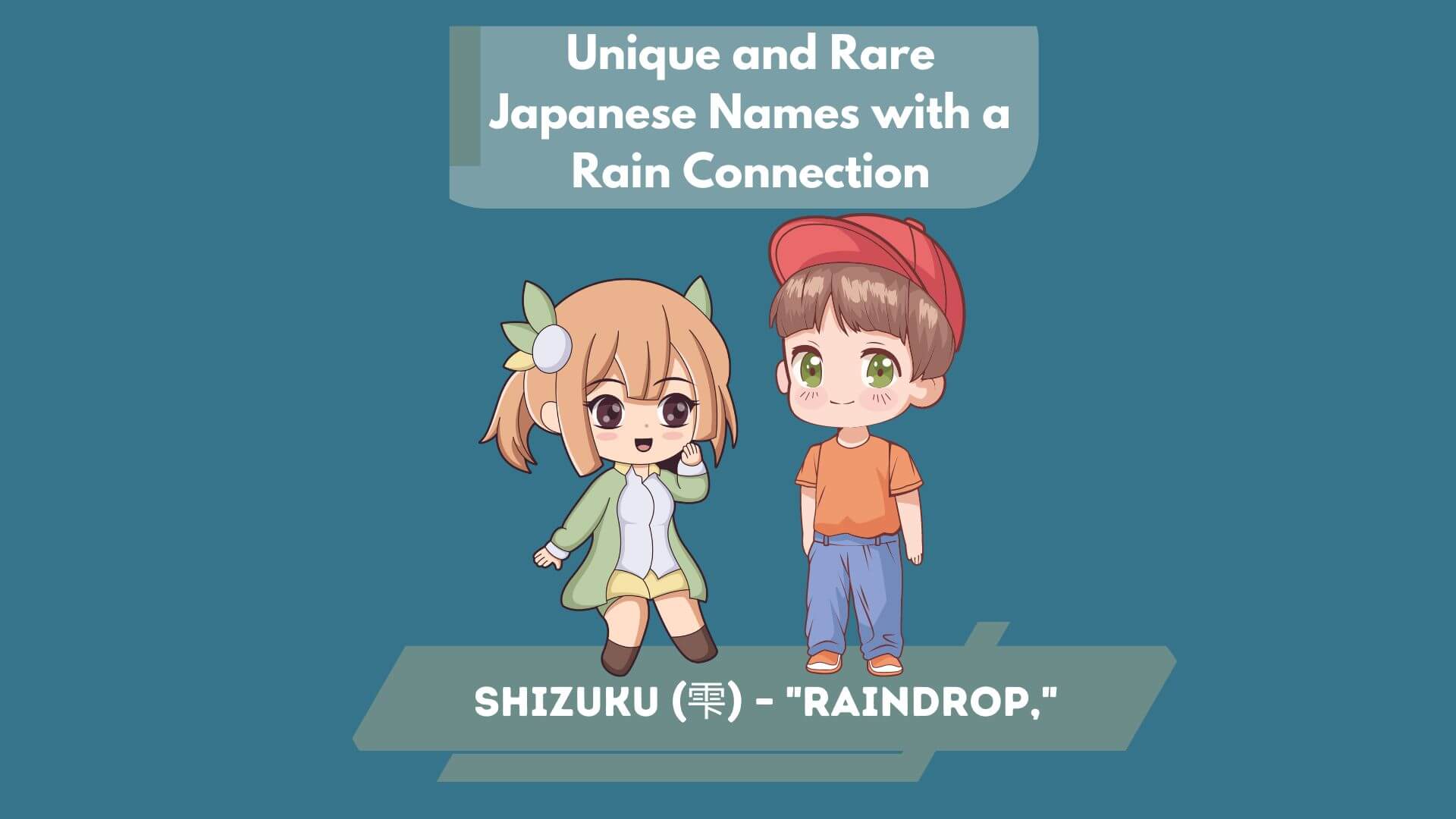
- Ameyuki (雨雪) – “Rain snow,” symbolizing the delicate balance between rain and snow in winter.
- Yuudame (夕雨) – “Evening rain,” capturing the soft, tranquil rains that fall at dusk.
- Amemaru (雨丸) – “Rain circle,” representing the cyclical nature of rain in the water cycle.
- Amekita (雨北) – “Northern rain,” symbolizing the crisp and refreshing rains in the northern regions.
- Amebina (雨日名) – “Rainy day,” signifying the calming, peaceful atmosphere of a rain-soaked day.
- Seirame (星雨) – “Star rain,” representing rain under a starlit sky, blending celestial beauty with nature.
- Amekaori (雨香) – “Rain fragrance,” capturing the unique scent that rises from the earth after rain.
- Tatsusame (竜雨) – “Dragon rain,” symbolizing the powerful and mythological presence of rain in ancient stories.
- Amehiko (雨彦) – “Rain prince,” representing nobility and the quiet strength found in rainfall.
- Soren (蒼雨) – “Blue rain,” evoking the serene, cool feeling of rain against a blue sky.
- Amekari (雨狩) – “Rain hunter,” symbolizing a connection to nature and the pursuit of rain’s life-giving properties.
- Fukasame (深霧) – “Deep mist rain,” representing a dense, quiet rain that merges with the mist.
- Amemizu (雨水) – “Rainwater,” symbolizing the essential purity of rain as a source of life.
- Hoshisame (星霧) – “Star mist,” evoking the image of rain falling like mist under a starry night.
- Ametsuru (雨映) – “Rain reflection,” representing the reflection of light and beauty through raindrops.
- Ameharu (雨春) – “Spring rain,” symbolizing renewal and the start of growth as rain falls during the spring season.
Also Read: 80+ Japanese Names That Mean Snow For Boys & Girls: A Cultural Dive
Japanese Names Inspired by the Rainy Season and Weather Events
The rainy season brings lots of weather changes and some Japanese names really capture this. For example, the name Kōu means ‘rain,’ covering the kind of rain that helps the earth come alive again. These names show how much people respect and value nature’s cycles.
- Tsuyu (梅雨) – “Rainy season,” representing Japan’s monsoon period and the rain that nurtures life.
- Arashi (嵐) – “Storm,” symbolizing the powerful and tumultuous energy of a rainstorm.
- Raimei (雷鳴) – “Thunderclap,” reflecting the sound that often accompanies heavy rain during a storm.
- Shigure (時雨) – “Drizzle in late autumn,” representing the gentle rain characteristic of the changing season.
- Kaminari (雷) – “Thunder,” evoking the energy of thunderstorms that bring rain to the land.
- Samidare (五月雨) – “Early summer rain,” symbolizing the fresh, nurturing rains that come in May.
- Amefuri (雨降り) – “Falling rain,” depicting the consistent and steady fall of rain from the sky.
- Kirisame (霧雨) – “Mist rain,” representing the light, misty rains that create an ethereal atmosphere.
- Taifuu (台風) – “Typhoon,” symbolizing the intense and dramatic weather events that bring heavy rain.
- Niwakaame (俄雨) – “Sudden rain,” capturing the unexpected and quick downpours during weather changes.
- Fuurin (風鈴) – “Wind chime,” evoking the soothing sound of wind and rain together in the rainy season.
- Ametsuchi (天地) – “Heaven and earth,” symbolizing the connection between sky and earth through rain.
- Kumoame (雲雨) – “Cloud rain,” representing the dark, rain-laden clouds that precede a shower.
- Kozame (小雨) – “Light rain,” reflecting the soft, delicate nature of a gentle rainfall.
- Yuudachi (夕立) – “Evening rainstorm,” symbolizing sudden rain in the evening during warm months.
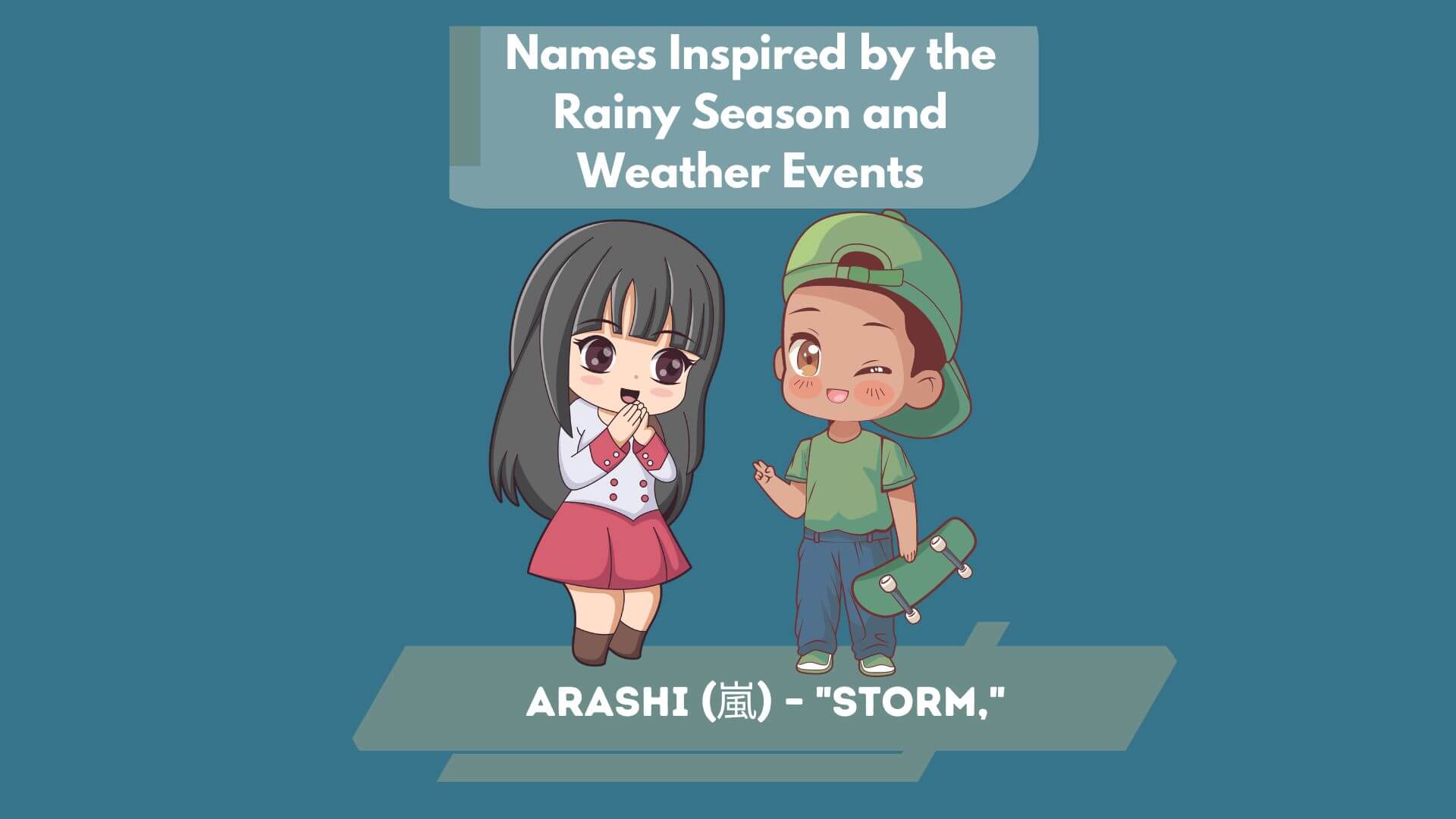
- Shinrai (震雷) – “Quaking thunder,” representing the strong rumble of thunder during heavy rain.
- Oobore (大降れ) – “Heavy rain,” depicting a downpour that saturates the ground and fills rivers.
- Reisame (霊雨) – “Holy rain,” symbolizing the cleansing and purifying aspect of rain in nature.
- Amakumo (雨雲) – “Rain cloud,” representing the dark clouds that herald an incoming rainstorm.
- Namidaame (涙雨) – “Tearful rain,” symbolizing the sorrowful yet calming rain during emotional times.
- Amebachi (雨鉢) – “Rain in a basin,” evoking the image of collected rainwater, a life source in nature.
- Kazekiri (風切り) – “Wind cutter,” symbolizing the sharp wind that slices through the air before a storm.
- Nokisame (軒雨) – “Eaves rain,” representing the soothing sound of raindrops dripping from the eaves.
- Oroshi (颪) – “Mountain wind,” evoking the strong winds that bring rain to mountain regions.
- Takaame (高雨) – “High rain,” symbolizing rain falling from high mountain clouds.
- Amekawa (雨川) – “Rain river,” reflecting the way rain swells rivers and flows through nature.
- Kazemizu (風水) – “Wind and water,” symbolizing the harmonious relationship between rain and the wind.
- Ameyui (雨結) – “Rain’s bond,” representing the connection rain creates between sky and earth.
- Shinsame (深雨) – “Deep rain,” symbolizing long-lasting, nourishing rains that soak deeply into the earth.
- Mizore (霙) – “Sleet,” capturing the wintry mix of rain and snow that falls during colder months.
- Yamaame (山雨) – “Mountain rain,” symbolizing the refreshing rains that fall over mountains and forests.
Conclusion
Japanese names that mean ‘rain’ really tap into the culture’s appreciation for nature and renewal. These names aren’t just about the weather; they tie into deeper ideas about life and nature’s cycles. They show respect for how nature impacts our lives, blending the natural world with cultural identity seamlessly. When we look at these names, it’s clear how much value is placed on living in harmony with the environment. Keep visiting Paige Simple for more articles like this.

Emily Carter is the creative genius behind Paige Simple’s beautiful coloring pages and printables. With a background in graphic design and a flair for creativity, Emily ensures every design is both fun and inspiring. Outside of work, Emily enjoys painting, visiting art galleries, and spending time with her dog, Max. Explore Emily’s creations for a burst of color and creativity in your day!

